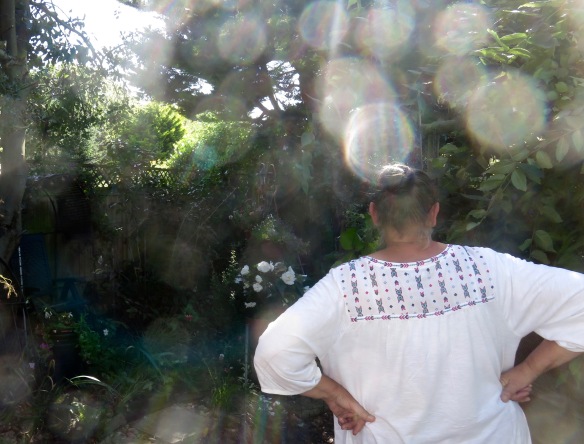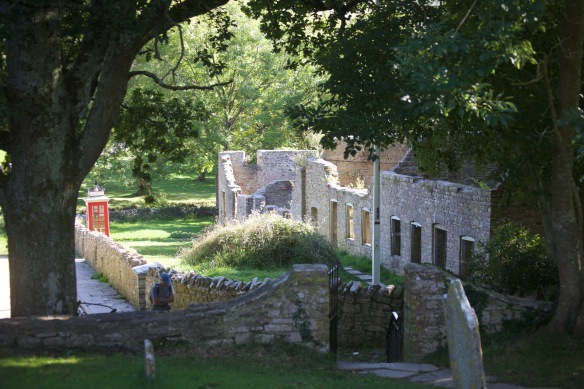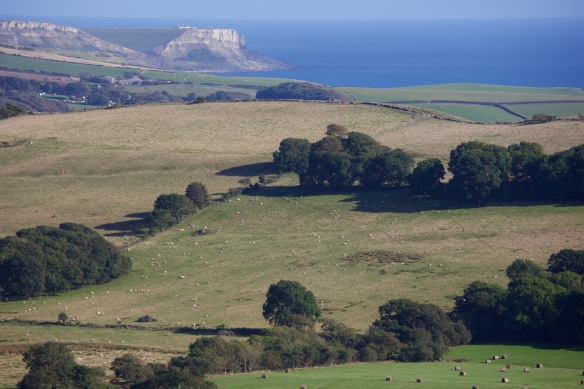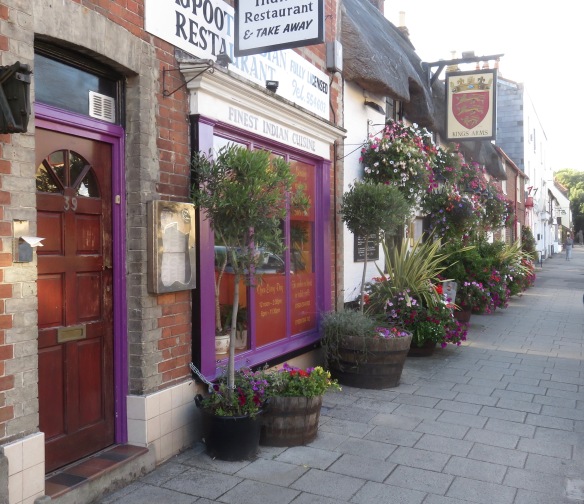CLICK ON IMAGES TO ENLARGE. REPEAT IF REQUIRED.
This morning, Aaron and Sean cleared space for the anticipated greenhouse. Holly and Bay trees were cut back and Jackie’s old work corner dismantled.
The sun danced over Jackie’s head as she contemplated the opening.
This afternoon Jackie drove us to Tyneham in Dorset and back.
Now uninhabited for the last 73 years, Tyneham was a thriving village from a previous age, until the villagers were ordered to leave their homes as part of the war effort in 1943. They were never allowed back. Today the remnants of this community were swarming with visitors.
The story of its century of change is fixed to a wall near the telephone box. All will become clear when this photograph is enlarged.
The replaced telephone box bears it own story,
as does the shell of the Post Office.
Most of the buildings are now ruined husks
revealing such as fireplaces,
and vacant windows fitted with stout wooden supports.
Exceptions are the school and the church. Jackie waits for me in the shadows outside
the schoolroom where there is a permanent exhibition. Here are the children’s desks.
The teacher’s faces down the classroom. Note the cane.
Queen Victoria and King George V hang on the wall.
The school photograph from 1912 features, third from right on the front row, Fred Knight.
We met a man who had worked with this former pupil some twenty years ago. Apparently, after Fred’s wife died, he often returned to the village to sit and think. In the second of these rows of coat hooks, young Frederick’s coat hanger is clearly labelled.
Did this lad and his classmates gaze through the schoolroom window and contemplate where they may be laid to rest one day? If so, this was not to be.
One gentleman who had grown up in Tyneham did come back to be buried there in 2010, to be joined by his wife five years later.
Beyond the churchyard, as from anywhere else in the village, can be seen the Purbeck Hills.
The Century of Change board pictured above tells us that it is Evelyn Bond who pinned the notice to the church door on the day the village died.
Priests first washed their hands in the piscina behind the font more than 700 years ago.
With their own little dog straining at the leash, a couple ascended the slope beyond this tethered collie
which was unperturbed as they loomed into silhouette.
Beyond the Military Firing Range on Povington Hill
we can see how close the sea is to the low-lying village. If you examine these pictures carefully, you should be able to distinguish between hay bales and sheep in the fields.
As we approached Wareham on our return journey it became apparent that the road home was very busy. There was therefore only one course of action.
We turned off into this very attractive town and sought out The Rajpoot Indian restaurant. It was not yet open, so we dropped intoThe King’s Arms next door for drinks. The restaurant itself was first class. I enjoyed king prawn naga, as Jackie did her chicken shashlick. We shared the chef’s secret spice rice, an egg paratha, and an onion bahji. We drank small bottles of Kingfisher.

































Thanks for sharing some of the history of Tyneham Village, Derrick…so interesting. Your photos of Povington Hill are amazing!
Thanks very much, Jill. Now I’m knackered and off to bed just before midnight 🙂
LOL! Sleep well. 🙂
The bittersweet, mixed-up emotions provoked by such places as Tyneham— where the lives of ordinary citizens were so heavily touched by the necessities of the collective, continuous battle of governments round good and evil—it is such a conundrum, and always invites our questions and our awe. As we in the US remember September 11, 20001 today, I find myself weary of it all, yet knowing we still must look at it, and judge it for what it was, and is.
As usual, a finely written comment.
Tyneham, along with other war-deserted villages across the country leaves a great deal of bitter resentment in that dwindling number of survivors who were forced out, and in their families who’ve had to live under the shadow of parents/relatives being uprooted. The issue isn’t that it happened, or that it could do so in a so-called civilized country, but that the government/military have been so adamant about not letting them back, apparently content to drag their heels until the residents died off and, with them, the moral duty to offer them restitution. I gather in most cases the villagers were promised the certainty of returning after the war, a promise presumably made to secure their agreement, with no intention of its ever being honoured*. It’s a scandal, frankly. There are several low-level campaigns around, trying to achieve some measure of justice for those who did [rather more than] their bit for the war effort.
*spelt with a ‘u’, despite the spell-checker trying to persuade me otherwise 🙂
I sympathize with those campaigns for justice and agree…In their zeal for “the big picture.” gpvernments often conveniently forget promises made to ordinary people. It is truly a shame that the promise of return after the war was not honoured. Is Tyneham still being used as a military installation? Why? Time heals all wounds, perhaps, but also, inevitably, will wound all heels.
A vast area is now owned by the Ministry of Defence. There are many days when you can’t visit the village because the firing ranges are in use. Nice pun.
Good stuff, Paul
Profound as ever, Cynthia. It was an appropriate day on which to visit – something must have led us there then. Thank you.
Most interesting! Is young Fred Knight a relative? Though tiredness probably caused you to mislabel the school pics as 2012 instead of 1912. <3
I too wondered about the infinitely faint possibility that there might be a connection.
Strangely enough, Pauline, Jackie thought he looked a bit like me. You are right about the date. I’ve just amended it. I could hardly keep awake 🙂 Thank you.
Anyone who believes that making war is about destroying an enemy is an idiot.
Yes. Very true. Thank you, Mary
Such a poignant post. Lest we forget so many things.
Thank you, Susanne
Nicely said, Suzanne.
Whoops – Susanne.
How sad to see this deserted village, but good to see remnants of ages past. Those labelled coat hooks remind me of my first day at school.
Looks like a very attractive town you dined in.
Thanks, Vicki. I think you would have loved Wareham
The name Wareham doesn’t ring a bell and I’m sure I would have loved those colourful tubs of flowers.
The whole street was like this
This is really sad and an injustice. It’s good people can tour it, so that it won’t be forgotten. Pictures of the countryside around show how beautiful it is. I’m glad you had a nice drink and a good meal at the end of it.
Many thanks, Lisa. It is
It feels so symbolic to read this post today when my thoughts are going back 15 years to the tragic events. Thank you for sharing this piece of history, Derrick, and for your beautiful photographs.
Many thanks, Inese. Yes, it was a good time to go there.
It’s interesting who pays for the wars and the men who start them.
Isn’t it just, Widdershins? And it never stops
indeed
Fascinating post, Derrick, with lovely photos.
Thank you, Ann
What a fascinating time capsule of a place. It’s sad that the inhabitants were never able to return, but in a way it means the village continues today as a kind of poignant memorial to all those who sacrificed in the terrible but necessary struggle against Nazism.
Thanks very much, Bun
What a fascinating post although I am shocked to note that even in civilised countries you can be expropriated without any compensation. I can’t believe that none of the villagers have descendants who would have been able to claim their right. At the least they could use it as a tourist space for compensation their ancestors were entitled to. It’s sad really to see such abuse of basic rights in a country where it is not supposed to happen.
Despite it all you’ve taken some really wonderful photographs that show the beauty of the place and instill peace in it.
I love the restaurant and the whereabouts of the town where you dined.
While looking at the photographs and the one of the little town where you dined, I was thinking you would probably like the medieval town of Yvoire a lot. It is in France on lake Leman, not far from Geneva. I am sure you would take some wonderful photographs there.
Many thanks, Geetha. It is indeed shocking. You are right about French medieval towns. I like the bastide ones in Acquitaine.
Most welcome Derrick! Yvoire is really a very special place. You have a real sense of going back in time despite the gift shops. I loved the place.
Military Firing Range or Secret Alien Site? I guess when you trust your government, you don’t wonder about things like that. 🙂
A very interesting and poignant post, Derrick. Thank you for sharing it with us.
Thanks very much, John
Reblogged this on History Undusted and commented:
Here’s a fascinating look into the history of the village of Tyneham, England, which died when the population was forced to evacuate in 1943. Enjoy learning about its legacy.
Thank you very much, Trinity. Off to look at your site
Enjoy! 🙂 Thank you for posting such an interesting history, with plenty of visuals!
Interesting post Derrick, with pictures cutting straight to the point.
Very many thanks, Quercus
Fascinating!
Thanks, Leslie
My ignorance astounds and ashames me …. I had never heard of Tyneham. When in England I will visit for myself.
Come and see us if you do. I didn’t know about it until we came down here to live. Thanks, Osyth
Oh, I’m certain I will and even more certain that I won’t pass by the opportunity to spend some time with you and The Head Gardener … how exciting 🙂
🙂
You may have to be organized about fixing a visit. Derrick may know more, but I think access is still restricted (maybe more to prevent squatters, from those sympathetic to the evicted residents, and the ensuing unwelcome headlines, than for any military safety reasons. Cynical? Moi?!) Derrick’s visit-dates co-incided with a nationwide Open Heritage Weekend which, as well as offering free access to many sites one usually pays to enter, also opens sites normally private/closed, for whose permanent opening funding can’t be found. Tyneham may be one of these.
Thank you, Paul … I will certainly do my research to see if I can find a time for a visit. Planning is my middle name, to my husband’s well disguised frustration, and living abroad means I have to make best use of my time when I’m in Britain so it would be jolly frustrating to turn up and find the place locked!
The available dates are on the Tyneham web site
I spent a day at Tyneham about 5 years ago. Strangely I felt comforted by this village as a memorial, knowing that the people were valued by us and would not be forgotten. All those little people who sacrificed for the greater good were all big people to many.
Thanks very much, Sol
Very interesting post, Derrick. It’s a sad story, but it’s good that the village is remembered in this way. 🙂
Thanks very much, Sylvia
What a fascinating place and story.
Thank you, Geoff.
Fascinating story. I’ve never heard of this town. Thank you for sharing, Derrick–and for your wonderful photos, of course.
Many thanks, Merril
Fantastic historical reading Derrick, I had never heard of deserted villages for the war effort, fascinating reading and great to see it was refurbished to its original, makes me wonder just how many other villages in England were appropriated for war work.
Thanks, Ian. There may well have been more
A fascinating day trip. I love the photos of the ruins. Tyneham must have been a prosperous village before 1943. Why didn’t they ever resettle it?
The countryside with its green fields, sheep and hay bales and view of the sea is beautiful.
The whole valley is still used for Ministry of Defence training. Thank you, Nicki.
Very interesting post, Derrick. Thanks for sharing. Wonderful photos.
Many thanks, Persia
<3 the story, the photos, and something more I can't put my finger on.
Thanks very much, Donna
What an outing! I love the two windows in the ruin.
Many thanks, Cynthia G